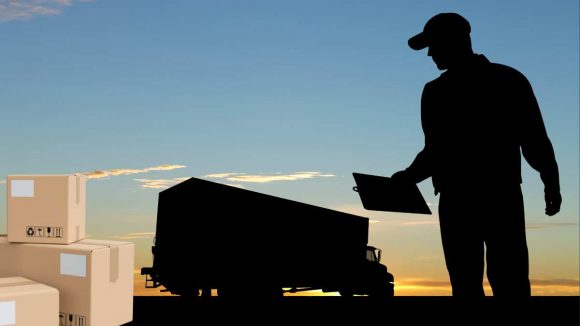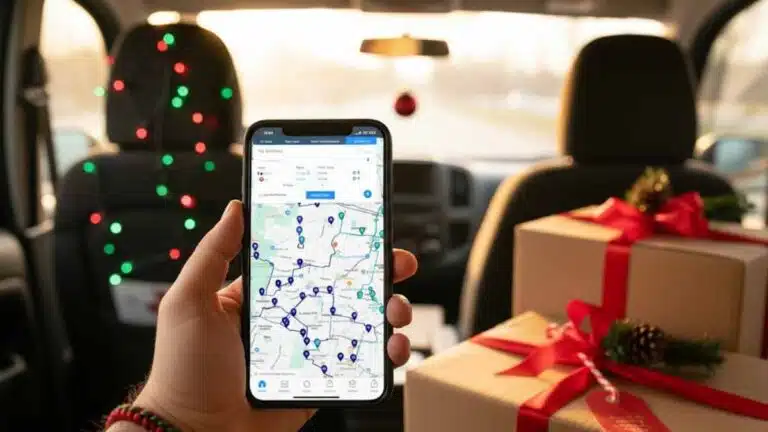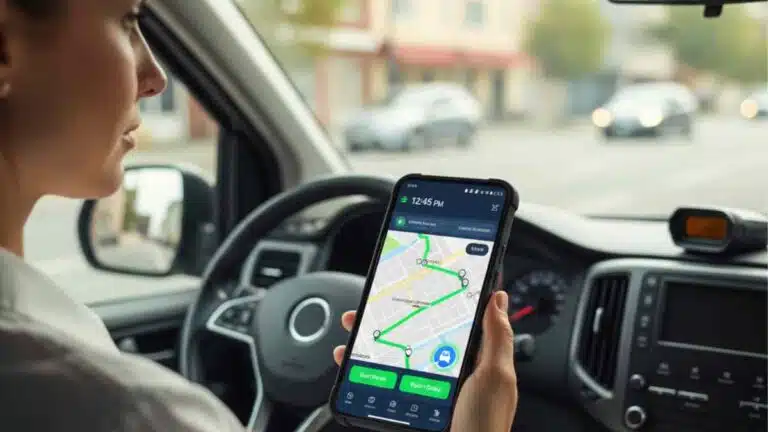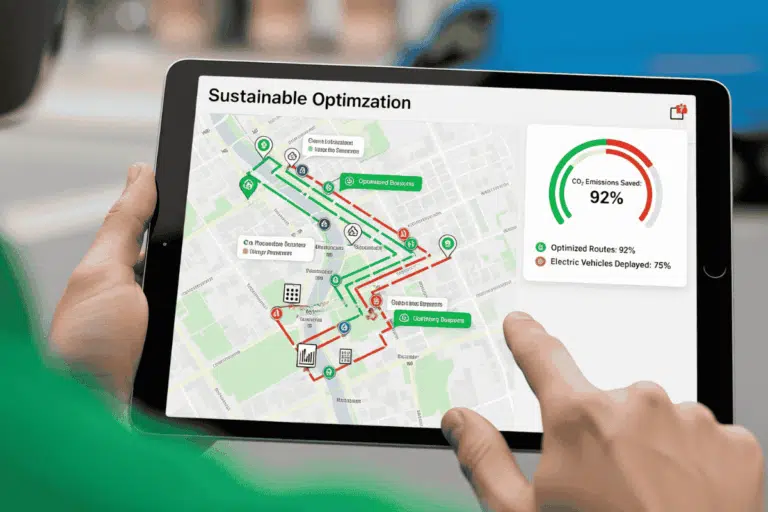The short answer is to learn to plan and dispatch smarter.
Hitting a hundred deliveries in a single day sounds like a win until you’re the one trying to make it happen. The first instinct is usually, “We’ll just add more drivers.” But it’s not the smartest (or cheapest) fix.
When you tighten up routes, cut out wasted mileage, and get more value out of the drivers you already have, you can push delivery volumes way up, without ballooning costs or creating chaos in the depot.
The good news? With the right technology and a few proven strategies, it’s not only possible, it’s surprisingly achievable.
In the next few sections, I’ll show you exactly how to streamline operations, keep your fleet productive, and reach 100-plus daily drops without burning out your drivers or your budget.
Why Hiring More Drivers Isn’t Always the Answer
It’s easy to think the quickest way to clear a delivery backlog is to throw more drivers and vehicles at the problem. On paper, it makes sense. More hands, more deliveries. But in practice, it rarely works out that neatly.
For one, hiring isn’t cheap. Recruiting, onboarding, and training new drivers takes time and money.
Then there are the extra costs of vehicles, fuel, insurance, and maintenance. And even if you absorb those expenses, there’s another catch: more drivers don’t automatically equal more deliveries per hour.
In fact, the bigger the fleet, the more complicated the dispatching becomes. Routes start overlapping, traffic patterns clash, and suddenly, your solution is creating inefficiencies instead of fixing them.
The thing is, the businesses that really nail high-volume delivery aren’t the ones with the biggest fleets. They’re the ones who know how to plan and dispatch smarter.
With the right software and a sharper approach, you can often double a driver’s daily stops while reducing stress for both them and your dispatchers.
The Core Challenges of High-Volume Dispatch
Once you push past 100 deliveries a day, the cracks in your system start to show. The biggest trouble spots usually come down to:
- Overlapping routes: Drivers covering the same areas, wasting fuel and time. The solution lies in route optimization to cut fuel costs and cash in on efficient routes.
- Traffic delays: Accidents, construction, or school zones are throwing off schedules. Most efficient routes are determined by software that considers all these conditions. Tracking job statuses also makes it easier to assign jobs better.
- Inconsistent service times: A quick 5-minute drop-off followed by a 30-minute one. This is not efficient resource allocation.
- You need efficient dispatch management. The delivery process can be smoother. The mismatch only derails efficiency. Dispatch software ensures timely deliveries.
- Vehicle mismatches: Sending the wrong van or car for the load also affects the delivery speed, impacting customer satisfaction. To ensure timely deliveries, you need better dispatch managers and a dispatch process.
- Lack of real-time visibility: Dispatchers flying blind without GPS tracking is a huge mistake. Real time visibility is a must for effective dispatch management.
Real time tracking software solves this problem. It also improves the overall operational performance, including customer satisfaction.
Each of these issues makes the dispatch process harder. You need effective dispatch management to execute a successful delivery process.
But here’s the upside: every one of them is fixable with the right system, and when you solve them, you unlock serious operational efficiency gains.
Maximize Delivery Output from Your Existing Fleet
The instinct when orders pile up is to hire more staff. You start panicking because all you want is operations running smoothly.
But before you add more salaries to your budget, take a closer look at your available resources. Adjust schedules, review your resource usage, preempt unexpected challenges, maximize productivity and improve response times, to stay ahead with your customer needs.
Most fleets have hidden efficiencies waiting to be unlocked. You just need the right approach to find them.
Here’s where to start:
1. Cluster routes into zones
Instead of sending drivers crisscrossing the city, keep deliveries grouped in proximity. It saves fuel, cuts down on wasted time, and makes routes more predictable.
With a route planner, clustering and sequencing stops are done automatically. Inefficient routing costs money, using the right tools will reduce costs.
2. Stagger driver start times
Do all your drivers need to leave the depot at 8 a.m.? Probably not. Minimizing travel time by dispatching drivers from the depot at different times.
That way you avoid bottlenecks, make better use of loading bays, and cover both early and late delivery windows. It will increase efficiency fast.
3. Plan the delivery day ahead
Saving time with packing more efficiently and smart is a game-changer. Loading it in the same sequence they’ll be dropped off saves your driver a significant amount of time.
That means there is less space for human error, and customer orders can be dropped off faster.
How can this be automated without stealing precious time? Using delivery management software, you can map this out before the first van even leaves the depot. Your fleet will work like a well oiled machine.
4. Maintain driver’s strengths
Some delivery drivers thrive in dense city traffic, while others are naturals at long suburban stretches.
Using data that can analyse each driver’s performance and ratings, it helps you assign the right person to the correct route.
5. Keep communication during delivery open
With real-time GPS tracking and proof of delivery tools, dispatchers can see precisely where drivers are, customers know when to expect their orders, and drivers have clear accountability.
The thing is, you don’t always need more people to get more done.
When you tighten up planning and give drivers the right tools, you can boost daily stops without adding to headcount or the associated headaches.
ALSO READ: 8 Proven Strategies to Reduce Delivery Costs Using Delivery Management Software
Dynamic Dispatching: Adapting Midday Without Chaos
Even the best delivery plan can unravel the moment the day begins. A customer cancels. A new order drops in at the last minute. Traffic snarls up because of an accident you couldn’t see coming.
The thing is, these curveballs aren’t the exception; they’re the norm once you’re running at scale.
That’s where dynamic dispatching makes all the difference. Here’s how:
- Re-optimize in real time: The right software can instantly rebuild routes when conditions change, so drivers aren’t wasting time backtracking or sitting in gridlock.
- Add slack buffers: Building small cushions into schedules means you’ve got breathing room for urgent jobs or unexpected delays.
- Push updates straight to drivers: With driver apps linked to your dispatch system, reroutes land instantly, keeping the day on track.
- Keep customers in the loop: Automated SMS with live tracking links cuts down on “Where’s my order?” calls and builds trust in your reliability.
Here’s why it matters: flexibility is what separates a fleet struggling to deliver 50 parcels a day from those dropping off 500 parcels a day with ease.
The delivery company that has the systems in place to adapt fastest when the day inevitably goes off-script is the one that thrives.
The Role of Route Optimization and Dispatch Software
Once you’re juggling 100 deliveries a day, pen-and-paper planning or even basic spreadsheets just don’t cut it anymore.
The complexity is too high, and the margin for error is too thin. That’s where route optimization software and modern dispatch management tools step in.
Here’s what to look for if you’re serious about scaling:
- Multi-stop route planning: Automatically generate the fastest, most efficient order of stops.
- Live GPS tracking: See exactly where drivers are and spot issues before they snowball. Make sure it’s not static maps.
- Proof of delivery: Photos, barcodes, or e-signatures to keep everyone accountable. It’s one of the most important documents you own.
- Automated customer notifications: Updates that keep shoppers informed, without clogging up your support lines, and boosts customer satisfaction.
- Driver app with turn-by-turn navigation: So drivers aren’t wasting time bouncing between apps. (What is a driver app?)
On top of that, integrations are critical. A dispatch and delivery planning system like Locate2u connects with Shopify, WooCommerce, Zapier, or even good old Excel imports, making it easier to slot into the tools you already use.
The real power comes from having everything in one place. Dispatch and delivery planning, real-time driver tracking, and customer communication. When all these systems work together, you are able to scale quickly.
Track the Right Metrics to Keep Scaling
If you can’t measure it, you can’t improve it. To keep scaling past 100 deliveries, track the right metrics:
- cost per delivery
- on-time delivery percentage
- stops per driver per hour
- deadhead or idle time
- driver utilization rates
Most delivery management software comes with dashboards for these KPIs, giving dispatchers the insights needed to make data-driven improvements. The more you measure, the easier it becomes to tweak your operation for higher efficiency.
How to get 10 deliveries to 100 or more
Scaling your delivery operations isn’t about making one giant leap. It’s about steady growth.
The truth is, what gets you through 10 deliveries a day won’t hold up at 100, and what works at 100 won’t get you to 1000.
Here’s how the operational efficiency journey usually looks:
- Around 10 deliveries a day: Manual planning still works. A spreadsheet, a whiteboard, or even memory can get you by at this stage.
- Between 50 and 100 deliveries a day: The cracks start to show. This is the point where route optimization software shifts from optional to essential. Without it, drivers spend too much time crisscrossing areas, and dispatchers waste hours trying to piece together routes.
- Between 100 and 500 deliveries a day: Now you’re firmly in high-volume territory. Dynamic dispatching becomes critical for last-minute changes, and automated customer notifications are no longer an option. They’re necessary to keep support calls under control and to boost customer satisfaction.
- At 500 deliveries a day and beyond: You’re running a large-scale operation. This is when you need to invest in a full transport management system (TMS) and consider hybrid fleets. Combining your core drivers with part-time contractors to handle surges in demand.
The important thing to remember is that growth isn’t just about adding more vehicles or drivers. It’s about building smarter systems at the right time, when you are not already under pressure.
FAQs
How many deliveries can one driver realistically handle in a day?
It depends on the setup. With efficient routes and quick service times, most drivers manage around 30–50 stops daily. But here’s the kicker: when you use route planning software and increase delivery density, that number can climb even higher without overloading the driver.
What’s the smartest way to handle last-minute route changes?
Surprises happen, orders pop up, customers cancel, traffic grinds to a halt. The best defense is a dispatch management system that allows real-time rerouting. With updates sent directly to a driver’s app, plans shift instantly without throwing the whole day off track.
What software is best for scaling dispatch operations?
The strongest platforms bundle together everything you need: route optimization, GPS tracking, proof of delivery, and customer notifications. Tools like Locate2u are designed to grow with you, whether you’re running a small fleet or managing hundreds of daily drops.
What KPIs are worth tracking?
Don’t drown in data, focus on the numbers that really matter. Keep an eye on:
- On-time delivery rate: Are you meeting promises?
- Cost per delivery: Is each trip profitable?
- Stops per hour: How productive are your drivers?
- Driver utilization: How much of their shift is spent actually delivering?
These metrics tell you whether your planning is working at scale or if it’s time to fine-tune.
About the author
Mia is a multi-award-winning journalist. She has more than 14 years of experience in mainstream media. She's covered many historic moments that happened in Africa and internationally. She has a strong focus on human interest stories, to bring her readers and viewers closer to the topics at hand.










